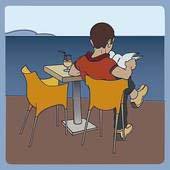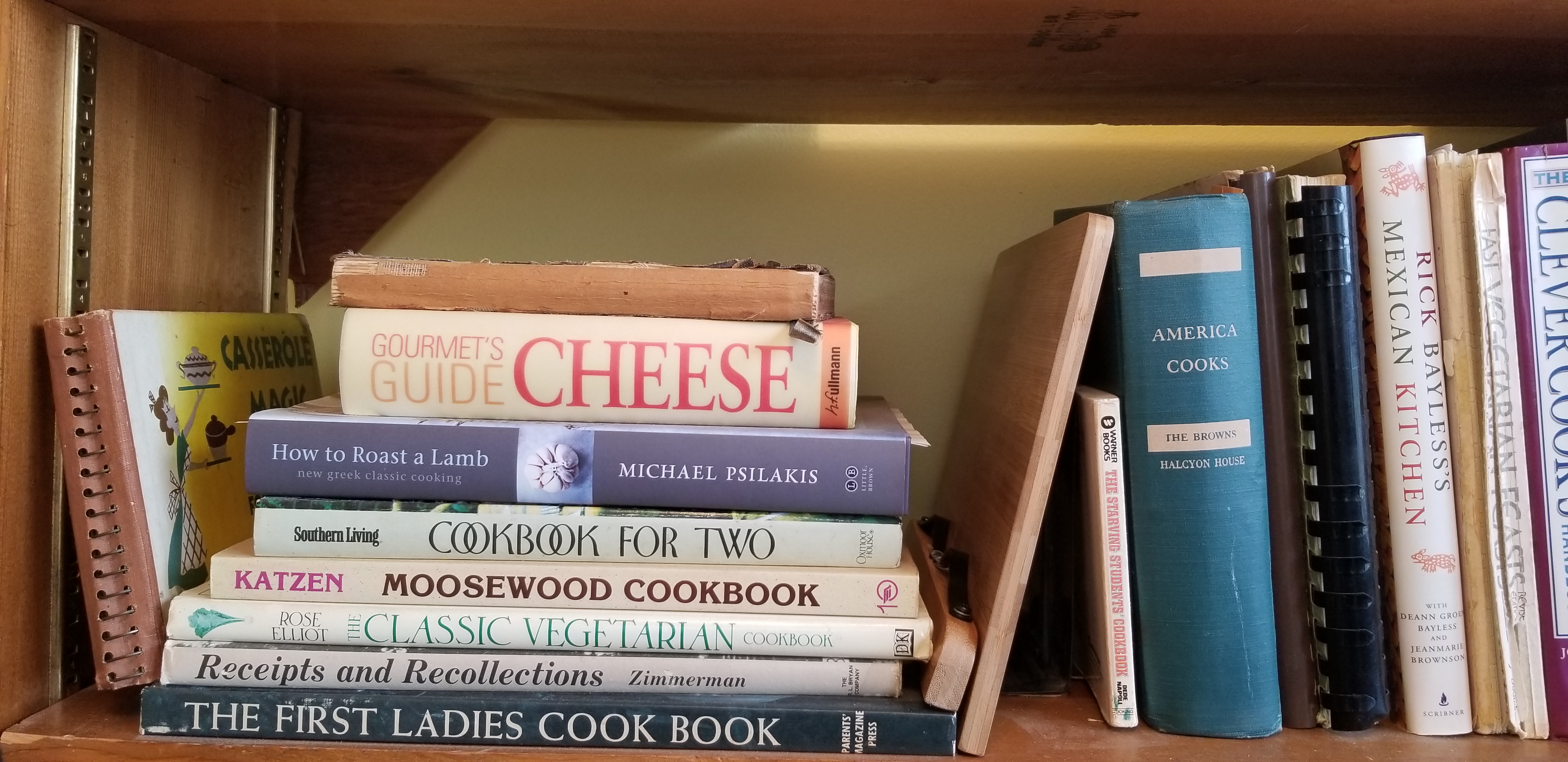 Welcome to the first installment of my “Cookbook Challenge.” As you may recall from an earlier post, I have decided to work my way from one end of my cookbook shelf to the other – one book at a time. For each one I will read, review, pick a random page (or pages), then prepare the recipe (or recipes).
Welcome to the first installment of my “Cookbook Challenge.” As you may recall from an earlier post, I have decided to work my way from one end of my cookbook shelf to the other – one book at a time. For each one I will read, review, pick a random page (or pages), then prepare the recipe (or recipes).
For those who prefer video to reading, I am including my YouTube video review of this first cookbook at the end of this post. Otherwise, read on!
The first cookbook, all the way to the left of the bookshelf, is one of many that I inherited from my grandmother. She lived from 1898 – 2001 and although her collection of cookbooks was not extensive, it spanned over 80 years of cooking. Many of the cookbooks we will explore during this challenge can rightfully be termed “vintage.” This first one is a perfect example.
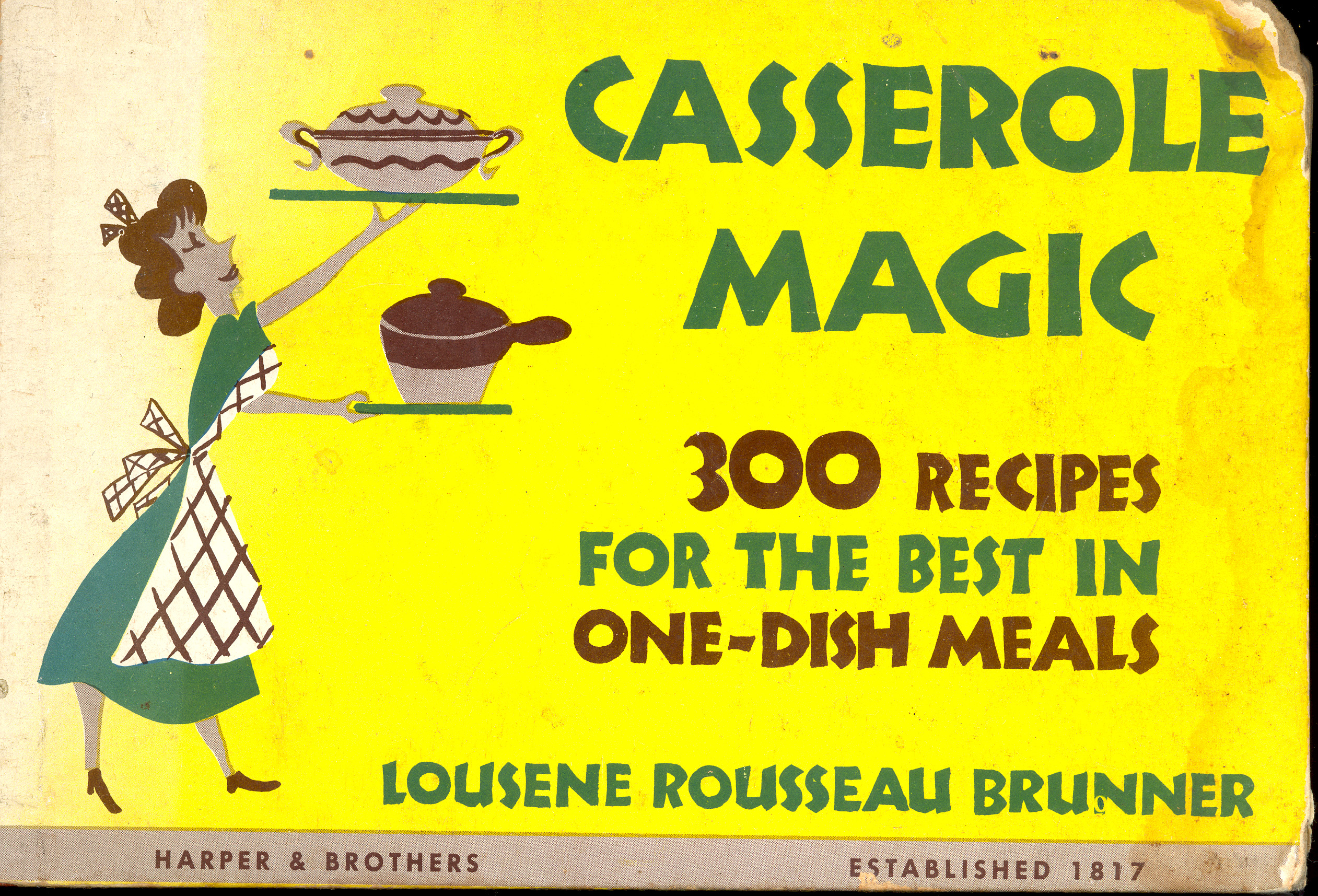 We begin with Casserole Magic: 300 Recipes for the Best in One-Dish Meals by Lousene Rousseau Brunner, published in 1953 by Harper & Brothers Publishers in New York. The book contains charming line drawings by Stephen J. Voorhies. All of the line drawings used in this post are his work from the book.
We begin with Casserole Magic: 300 Recipes for the Best in One-Dish Meals by Lousene Rousseau Brunner, published in 1953 by Harper & Brothers Publishers in New York. The book contains charming line drawings by Stephen J. Voorhies. All of the line drawings used in this post are his work from the book.
On the rear cover the price is marked as $3.00. According to my internet research, that equates to about $28.00 today. Not an inexpensive cookbook by any means.
I searched for quite a while online to see if I could find any information about the author, Lousene Rousseau Brunner. Sadly, nothing concrete seems to exist except a record of several other cookbooks. According to a combination of information from Amazon and Goodreads, she was also the author of Magic with Leftovers (1955), Casserole Treasury (1964), The Summer Cookbook (1966), New Casserole Treasury (1971) and New Casserole Treasury in Colour (1977). Clearly, she has a theme in her cooking passions.
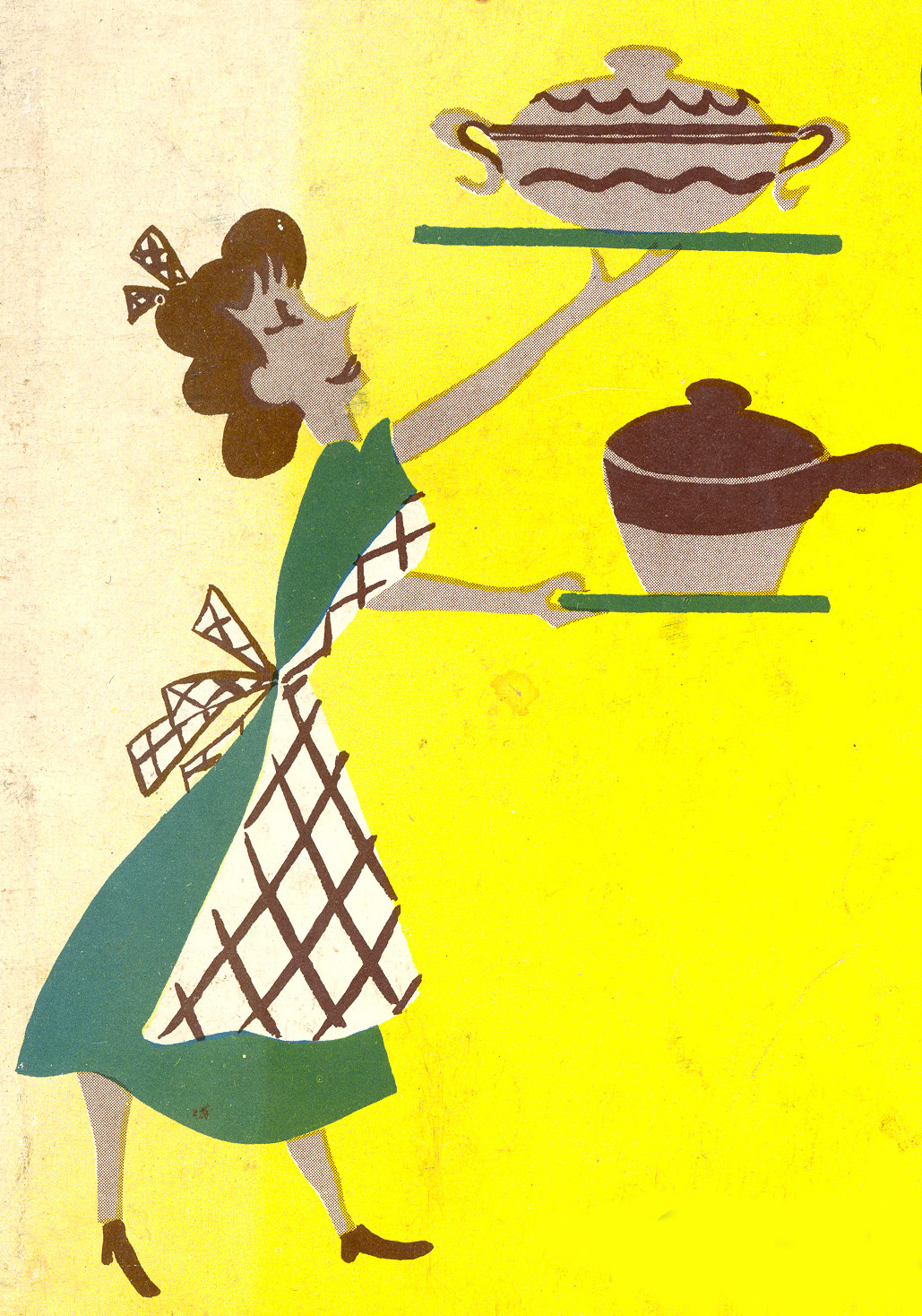 When I first picked up this cookbook, I was drawn to the stereotypical drawing on the cover – a woman in a crinolined dress, well coiffured, and wearing a decorative apron while serving casseroles. My first assumption was that this would be one of those old-school books extolling the virtues of things like “cream of mushroom soup” and “jello.” I felt suitably chastised when I sat down and began to read. This is a serious cookbook by a very knowledgeable and serious cook.
When I first picked up this cookbook, I was drawn to the stereotypical drawing on the cover – a woman in a crinolined dress, well coiffured, and wearing a decorative apron while serving casseroles. My first assumption was that this would be one of those old-school books extolling the virtues of things like “cream of mushroom soup” and “jello.” I felt suitably chastised when I sat down and began to read. This is a serious cookbook by a very knowledgeable and serious cook.
Brunner sets the stage by defining her purpose on page vii of the Foreword:
One simple principle has governed the preparation of this book: there is no excuse for dull or monotonous food. The hundreds of recipes collected here suggest a great variety of delectable dishes. Many of them are inexpensive – or perhaps it would be more accurate these days to say that they use cheaper foods. They provide many ways of using leftover food to create new dishes.
As I delved deeper into the book, I began to see that L.R. Brunner and I share a great deal when it comes to food. Later on that same page, she notes:
It is no part of the purpose of this book merely to shorten the process of food preparation. Prepared mixes and other short cuts have their place, but they contribute little to making either cooking or eating a joy, and that is what it should be.
A bit later, on page 2, she extols the virtues of cooking with wine:
Wine is a vital ingredient of some of the most appetizing casserole dishes, and its use adds distinction to all kinds of otherwise “plain” dishes. (Of course the alcohol in it evaporates almost at once, and only the flavor remains.) For superb results you do not need the fine table wines. Good domestic wines are perfect for the purpose, but they must be good. You can’t make a good dish with poor wine.
Clearly, she and I would have gotten along just fine.
In some ways, Casserole Magic is still a product if its times. Brunner uses feminine pronouns at all times when talking about cooks. She often refers to them as “housewives” and “hostesses.” One of my favorite 1950-centric quotes is this one from page ix of the Foreword:
The advantages of casserole cooking are almost too obvious to recount. Foremost among them, probably, is the act that most casserole dishes can be prepared some time in advance of mealtime, sometimes a whole day in advance. This leaves the housewife free for other last-minute chores – table setting, putting the children to bed, greeting guests calmly, or having a quiet cocktail with her husband – while the casserole cooks.
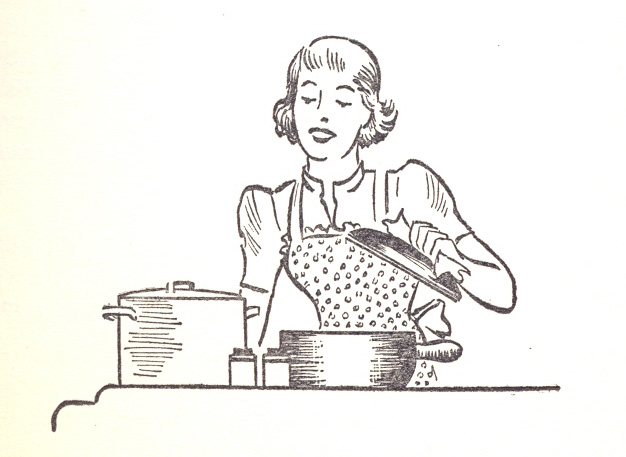 I have visions of June Cleaver meeting Ward at the door with a dry martini – attired in a crinolined dress, pristine apron, pearls, and high heels.
I have visions of June Cleaver meeting Ward at the door with a dry martini – attired in a crinolined dress, pristine apron, pearls, and high heels.
Once you get past some of the stereotypical moments, however, you then dive into an excellent cookbook. Brunner includes sections about the history of casseroles, the use of herbs in cooking, how to make herb butters, and a variety of inventive ways to marinate meats. Although she does tout the glories of a fantastic “new” product called “monosodium glutamate” I can forgive that when I look at the rest of this superb cookbook.
One of the things that fascinates me about vintage cookbooks is that inclusion of products and/or techniques that give an insight into the norms of the day. For instance, Brunner includes bacon fat as an ingredient in at least half of the recipes. The assumption, then, is that housewives in the early 1950s all had a ready supply of bacon fat in the kitchen. Actually, I remember this from my own childhood in the 1960s and early 1970s. My mother had a metal container on the stove which was a strainer for bacon fat.
Of equal interest are those things that Brunner writes about as being “new” or “innovative.” Like the idea of MSG being a fantastic new product, she also writes extensively about cooking with herbs as a new and daring innovation. The inside covers of the book contain charts of common herbs and how they should be used. In a section of the Foreword, she spends two full pages discussing the joys of using herbs in cooking, herbs that are not necessarily easy to find. She notes on page x of the Foreword:
American cooks are slowly becoming aware of the extent to which the skillful use of herbs can bring out food flavors. Dried bottled herbs in great variety are now carried by most “fancy” grocers and even by some chain stores.
If you do find a copy of Casserole Magic, you will probably be as intrigued as I was by the more inclusive definition of the word “casserole” used by the author. We generally think of casseroles as oblong and sometimes round Pyrex dishes that are used in the oven. For Brunner, the concept of casserole includes those cooking containers that are used for one-pot meals. Many of the recipes in this book are crafted to be prepared on the stovetop in things like the French marmite or a cast-iron Dutch oven. Many recipes involve cooking on the stovetop, then transferring the entire pot to the oven.
After the initial Foreword, Casserole Magic is divided into seven broad sections:
- Meats (Beef, Ham, Lamb, Pork, Veal)
- Poultry
- Fish
- Shellfish
- One-Dish Meals
- Vegetables
- Cheese, Eggs and Cereals
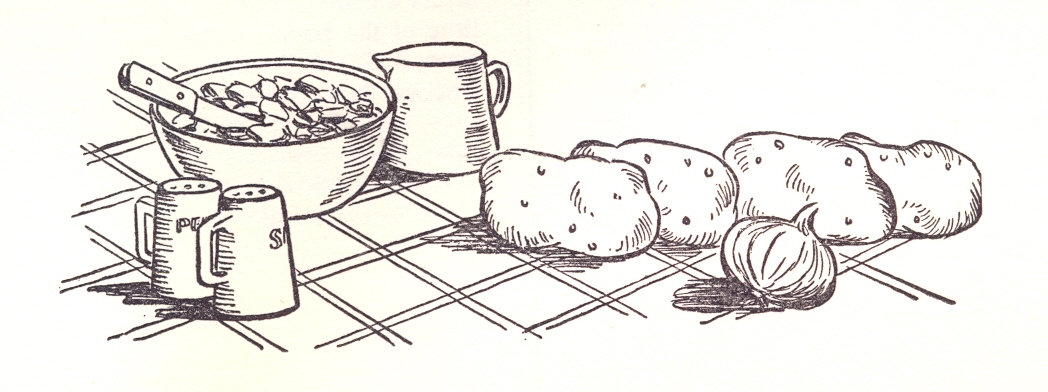 For all of the meat-centric sections, each recipe includes the author’s suggestions of sides to serve with the main course recipe. For instance, in the recipe for Flemish Beef Stew (page 13) she ends by saying, “Serve with buttered noodles or spaghetti, hot garlic bread, and a tossed salad of romaine or chicory.” Each recipe in these sections has similar (and often intriguing) suggestions.
For all of the meat-centric sections, each recipe includes the author’s suggestions of sides to serve with the main course recipe. For instance, in the recipe for Flemish Beef Stew (page 13) she ends by saying, “Serve with buttered noodles or spaghetti, hot garlic bread, and a tossed salad of romaine or chicory.” Each recipe in these sections has similar (and often intriguing) suggestions.
The section on “One-Dish Meals” contains those dishes that the author deems hearty enough to serve as a meal alone with the possible inclusion of garlic bread (for which she provides a tasty recipe on page 103). Here we find things like Lasagna, Spanish Olla of Beef, Chicken Curry, Kentucky Burgoo, Irish Stew, and such.
The section on cooking with vegetables starts on page 129 with one of the most fascinating passages in the book. She warns cooks not to boil vegetables in a lot of water, but to cook in “an absolute minimum of boiling water (except for cabbage), barely long enough to become tender.” The fascinating piece is this tidbit of advice, something I have never before seen or heard:
A new method of waterless cooking which can be done in any kettle produces vegetables that are a miracle of tenderness. The method is simple but takes a little longer than boiling. In any kettle at all melt one tablespoon of margarine or butter for every two portions of vegetables . . . Put vegetables in the kettle, add about one-half teaspoon of salt and a little sugar for two portions, stir well to coat with fat and seasoning, lay over the top a single layer of lettuce leaves, cover tightly, and cook without stirring, over very low heat, about twenty minutes.
What? I can only assume this is a way of steaming vegetables – so I wonder if the concept of a steamer basket was not prevalent in 1953? Any cooks who would recall that era, I would love to know!
Overall, as you can tell, I loved this cookbook. I recommend grabbing one of the few rare copies left on Amazon. The tips and tricks for things like making a perfect soufflé, easy browning of meat, using inexpensive cuts of meat, using leftovers, and more are all invaluable time-savers for any cook today.
And now, the moment we have all been waiting for (at least I hope)! During my video review (available on YouTube), I used a random number generation program to point out two recipes. You can find that section of the video beginning at 17:30, revealing the two pages containing the recipes I will prepare from Casserole Magic.
 The winning recipes are: Tuna-Fish with Noodles (page 89) and Quick Cheese Soufflé (page 161).
The winning recipes are: Tuna-Fish with Noodles (page 89) and Quick Cheese Soufflé (page 161).
Tasty? I’ll know soon!
There you have it! My next post (and my next series of videos both here and on YouTube, will be my preparation of those two recipes. This could get highly entertaining!
Epicuriously Yours,
Tommy
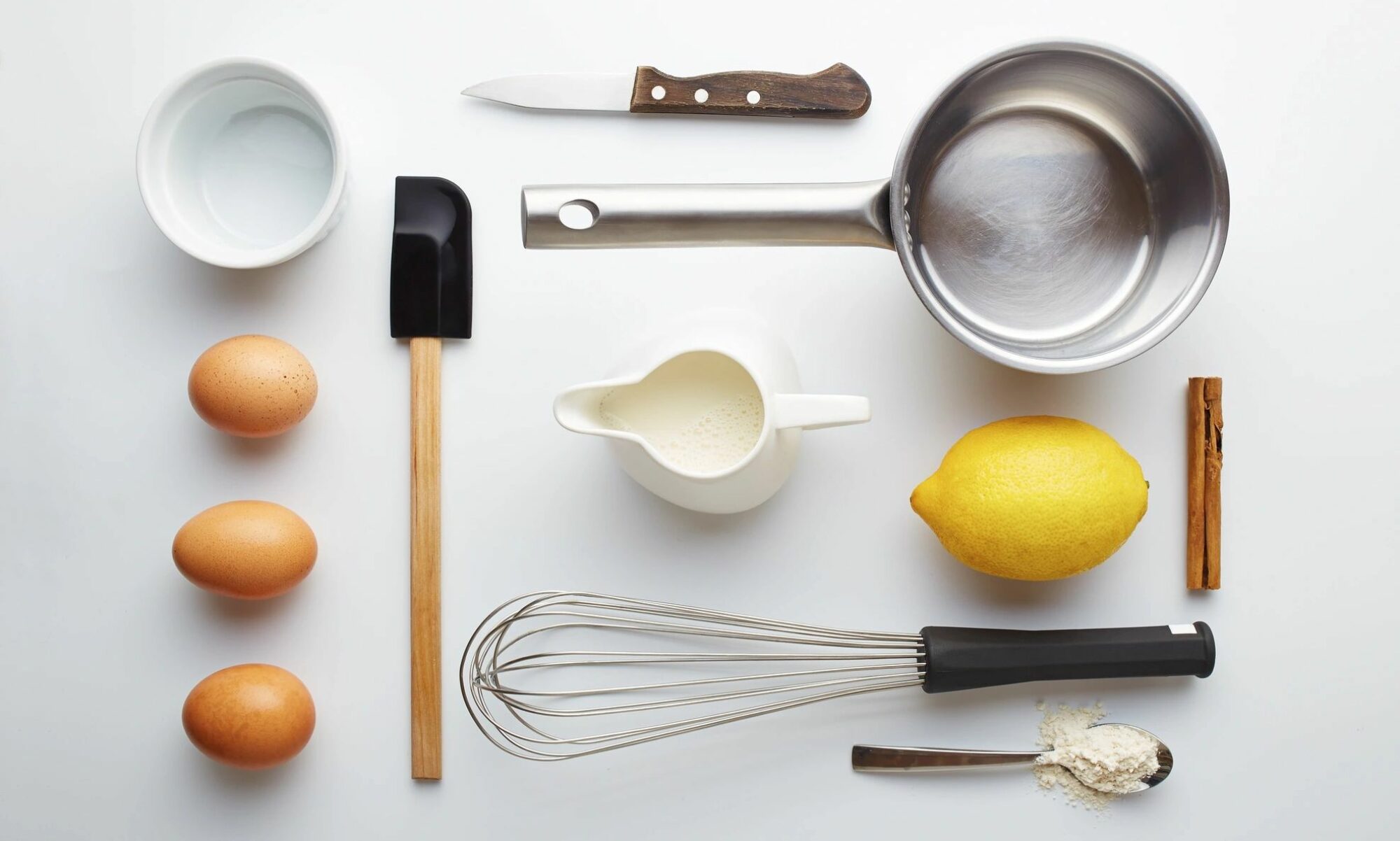
 Back in 2011 when I began “Table For One, Please” the focus was entirely on single dining at restaurants. I maintained that focus for a few years until a disastrous experience with a web hosting company resulted in the accidental deletion of all of my posts.
Back in 2011 when I began “Table For One, Please” the focus was entirely on single dining at restaurants. I maintained that focus for a few years until a disastrous experience with a web hosting company resulted in the accidental deletion of all of my posts. After pondering options, I suddenly had an epiphany.
After pondering options, I suddenly had an epiphany.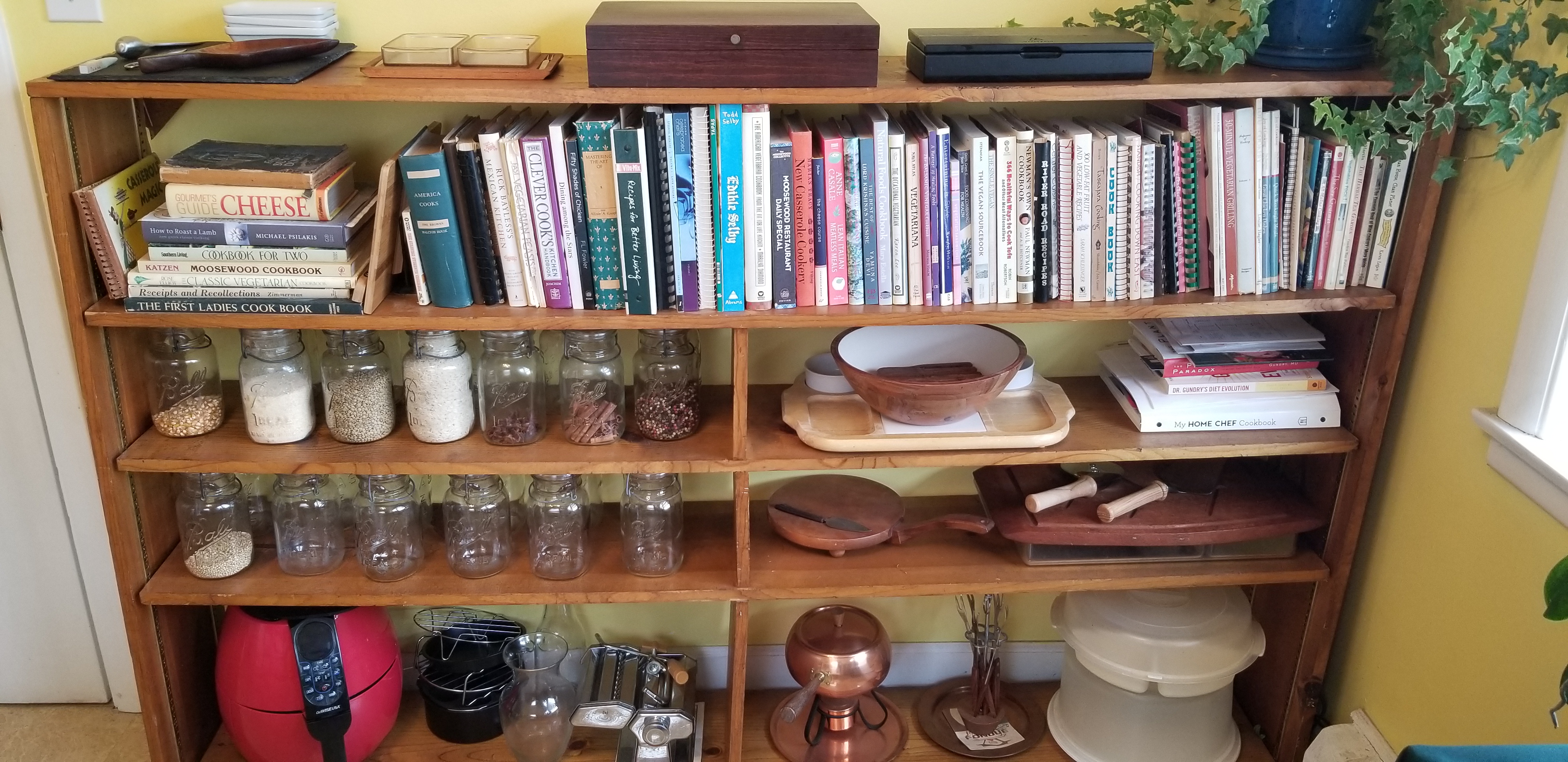 What if I were to read and review each cookbook and then cook something representative from each one, then write about it?
What if I were to read and review each cookbook and then cook something representative from each one, then write about it? I think this is going to be a blast!
I think this is going to be a blast!